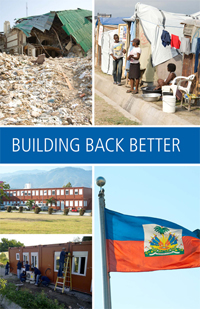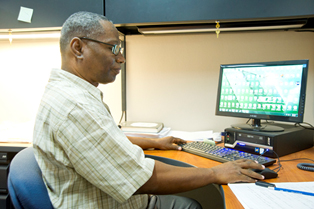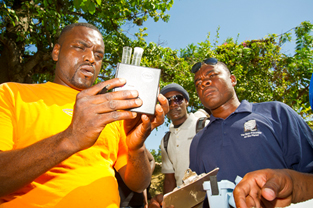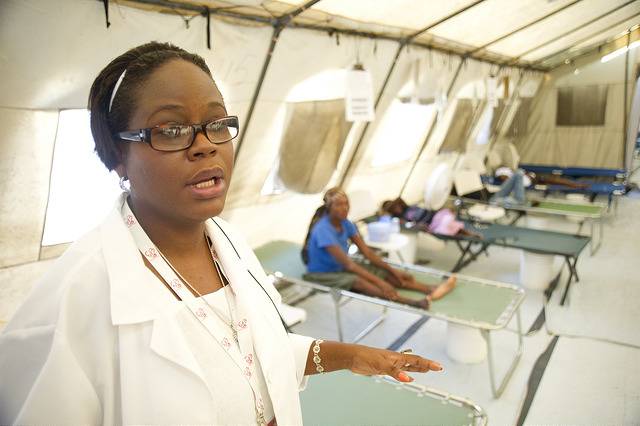 Showing visitors around his new offices at the Division of Epidemiology, Laboratory and Research in Port-au-Prince, Dr. Robert Barrais can hardly contain his pride. As head of surveillance of the division for the Ministry of Public Health and Population, Dr. Barrais has seen a world of change in his work, and his country, since a massive earthquake struck Haiti in January 2010. With much of Haiti’s health infrastructure destroyed, including his own offices, Dr. Barrais says much of that change has come about through the support of the Centers for Disease Control and Prevention (CDC).
Showing visitors around his new offices at the Division of Epidemiology, Laboratory and Research in Port-au-Prince, Dr. Robert Barrais can hardly contain his pride. As head of surveillance of the division for the Ministry of Public Health and Population, Dr. Barrais has seen a world of change in his work, and his country, since a massive earthquake struck Haiti in January 2010. With much of Haiti’s health infrastructure destroyed, including his own offices, Dr. Barrais says much of that change has come about through the support of the Centers for Disease Control and Prevention (CDC).
“To understand what we have now, you would have to have seen where we were working before,” Dr. Barrais said. “It was a very tiny space, just 3 meters by 10 meters, so we were very pleased to be given this building. It was difficult for us to believe we finally had a building of our own.”
 Seeing Haiti’s public health system in tatters, CDC acted quickly in the aftermath of the earthquake. Provided with $2.5 million in donations from the CDC Foundation through donors General Electric and the Robert Wood Johnson Foundation, CDC built a new facility on the grounds of the National Lab. Opened in 2012, the two-story building constructed by Proteus On-Demand, provides dedicated office space for Dr. Barrais’ surveillance department, which has been dealing with a deadly cholera outbreak in Haiti since 2010. And while the new office provides comfortable workspace, Dr. Barrais says the close collaboration with CDC staff on the building’s first floor is one of the greatest advantages of the new building.
Seeing Haiti’s public health system in tatters, CDC acted quickly in the aftermath of the earthquake. Provided with $2.5 million in donations from the CDC Foundation through donors General Electric and the Robert Wood Johnson Foundation, CDC built a new facility on the grounds of the National Lab. Opened in 2012, the two-story building constructed by Proteus On-Demand, provides dedicated office space for Dr. Barrais’ surveillance department, which has been dealing with a deadly cholera outbreak in Haiti since 2010. And while the new office provides comfortable workspace, Dr. Barrais says the close collaboration with CDC staff on the building’s first floor is one of the greatest advantages of the new building.
“Working with CDC helps us because we share reports and coordinate action in the field,” Dr. Barrais said.
We benefit from CDC technical advice as well as financial support.
With the acute phase of the earthquake response over, the public health focus in Haiti now is on long-term disease surveillance, a task for which Haiti was not well equipped before the influx of emergency post-earthquake aid.
“We had 54 surveillance sites set up just after the earthquake. Now we have 107 sites, and we have additional surveillance officers supported by CDC,” Dr. Barrais said. “With the help of these surveillance officers, we can detect any cases of disease at the institutional level, and we can mount a response within 48 hours.”
 In 2010, Haiti suffered a very serious outbreak of cholera, which is a severe bacterial infection caused from drinking contaminated water or eating contaminated food. With nearly 8,000 people dead since the outbreak began, the epidemic has driven home the need for stringent disease surveillance in Haiti. There again, Dr. Barrais says, "Collaboration with CDC has both bolstered the capacity of the department and brought about a dramatic shift in Haiti’s approach to public health."
In 2010, Haiti suffered a very serious outbreak of cholera, which is a severe bacterial infection caused from drinking contaminated water or eating contaminated food. With nearly 8,000 people dead since the outbreak began, the epidemic has driven home the need for stringent disease surveillance in Haiti. There again, Dr. Barrais says, "Collaboration with CDC has both bolstered the capacity of the department and brought about a dramatic shift in Haiti’s approach to public health."
“With the cholera outbreak in 2010, it demonstrated the necessity of collecting and transmitting data,” Dr. Barrais said. “Since then, there has been a change in attitude at every level.”
Cholera continues to claim lives, and Haitians face continued public health threats from diseases like tuberculosis, meningitis and measles. But working now in a new office building rather than a temporary space, just steps from his CDC partners, Dr. Barrais says he and his team appreciate more than ever the support provided by CDC.
“We have a lot left to do. We need more resources,” Dr. Barrais said. “But we have a lot more than we used to.”
